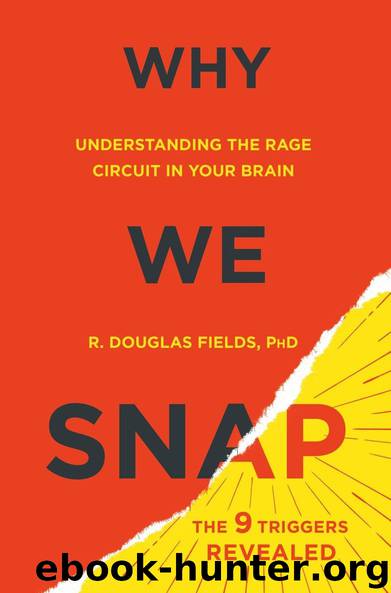Why We Snap: Understanding the Rage Circuit in Your Brain by Douglas Fields

Author:Douglas Fields [Fields, Douglas]
Language: eng
Format: epub
Publisher: Penguin Publishing Group
Published: 2016-01-11T23:00:00+00:00
LIFEMORTS Trigger Circuits
Drawing exact parallels from rodent brains and rodent behavior to human brains and behavior is difficult, but these newly identified circuits can be roughly extrapolated into the LIFEMORTS triggers of human fear and aggression in the following way: The Life-or-limb trigger is the defensive response to injury, which is associated with pain. If something or someone inflicts pain on you, you will immediately respond aggressively to prevent further injury. Similarly, animal aggression in response to attack by a predator also encompasses the Life-or-limb trigger to defend oneself violently.
Aggression among individuals of the same species is how dominance is established in animals, from fish to primates. In humans, with our unique ability to use complex language, verbal insult achieves the same purpose: the Insult trigger, as examined in chapter 4 on the claw-hammer homicide at Carderock. The Organization trigger (social order) also involves violence within the same species to maintain social order. Not all animals are highly social, but those that are utilize violence to maintain compliance with social rules. Fear and threat circuitry activated by members of the same species (conspecifics) in animals, provokes anger and violent responses in human brains when other people do not follow social rules—if they don’t stop for a red light or cut in line, for example. We have already considered the Family trigger to protect one’s family in our discussion of animal research on maternal aggression.
The amygdala has several subregions, which we will refer to simply by their initials: L, BL, BM, ME, and CE. (For those interested in neuroanatomy, these correspond to lateral amygdala, basolateral amygdala, basomedial amygdala, medial amygdala, and central amygdala.)
A brief primer on the neuroanatomy of the amygdala will be helpful in understanding the fear and threat-detection circuitry in this brain region. The amygdala is an almond-shaped lump of tissue deep inside the temporal lobe of the brain. The amygdala looks different depending on how you slice through it, but in looking face-on at an MRI of the human brain at a slice through the top of the head, shoulder-to-shoulder, taken at about the level of the ears, the amygdala looks like a pair of narrowly spaced eyes, framed by the temporal lobes on the left and right sides of the brain. Each of the ingoing and outgoing connections in the amygdala forms a small knot of neurons, and these are clustered at different spots inside the amygdala. Early anatomists could clearly see these neuron clusters in their microscope slides, but they named them long before the function of any of these hubs of communication in the amygdala was known. So, unfortunately, the names (and the initials we use to refer to them) reflect little more than their location inside the amygdala. Thus we have central, lateral, and medial nuclei (clusters of neurons), as well as nuclei that sit in transitions between zones and in subdomains within zones; for example, basolateral (lower-left), and centromedial nuclei (in the middle of the middle!).
By analogy, one can view the amygdala as a map of Manhattan.
Download
This site does not store any files on its server. We only index and link to content provided by other sites. Please contact the content providers to delete copyright contents if any and email us, we'll remove relevant links or contents immediately.
Should I Stay or Should I Go? by Ramani Durvasula(6785)
Why We Sleep: Unlocking the Power of Sleep and Dreams by Matthew Walker(5641)
Fear by Osho(4085)
Flow by Mihaly Csikszentmihalyi(4052)
Rising Strong by Brene Brown(3780)
Why We Sleep by Matthew Walker(3772)
Too Much and Not the Mood by Durga Chew-Bose(3694)
How to Change Your Mind by Michael Pollan(3678)
The Hacking of the American Mind by Robert H. Lustig(3580)
Lost Connections by Johann Hari(3455)
He's Just Not That Into You by Greg Behrendt & Liz Tuccillo(3302)
Evolve Your Brain by Joe Dispenza(3051)
What If This Were Enough? by Heather Havrilesky(2945)
Resisting Happiness by Matthew Kelly(2887)
Crazy Is My Superpower by A.J. Mendez Brooks(2860)
The Courage to Be Disliked by Ichiro Kishimi & Fumitake Koga(2796)
The Book of Human Emotions by Tiffany Watt Smith(2770)
Descartes' Error by Antonio Damasio(2731)
In Cold Blood by Truman Capote(2685)
